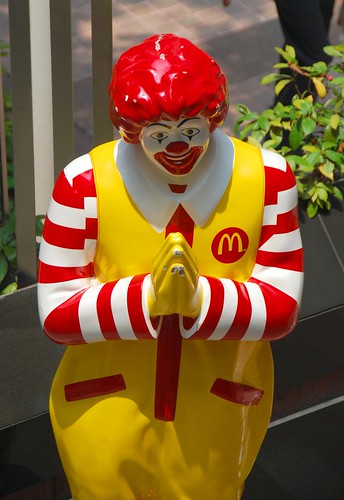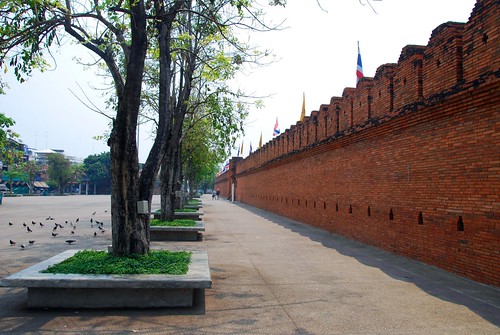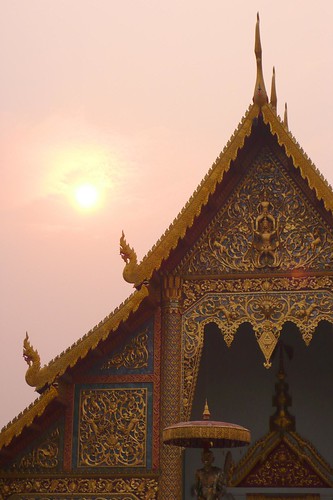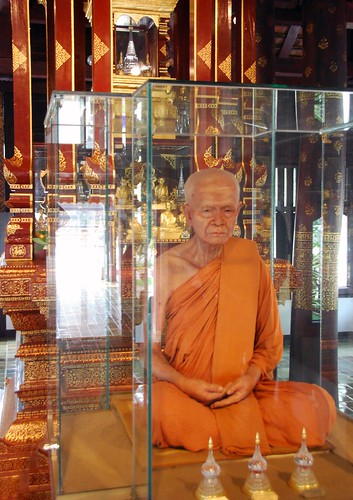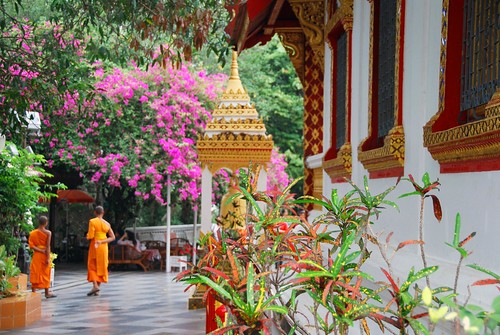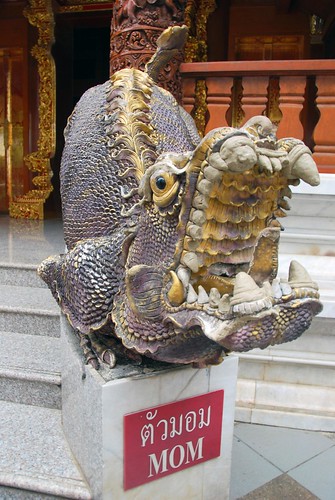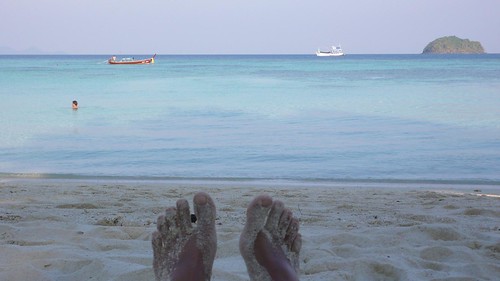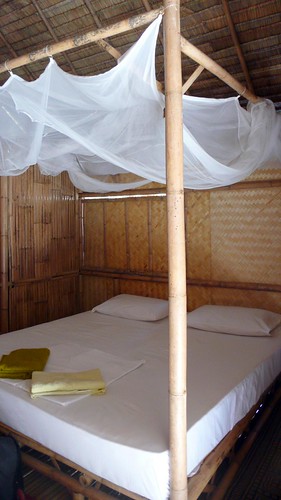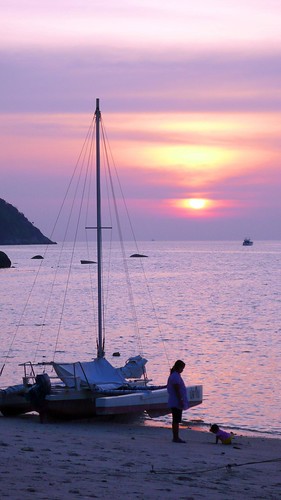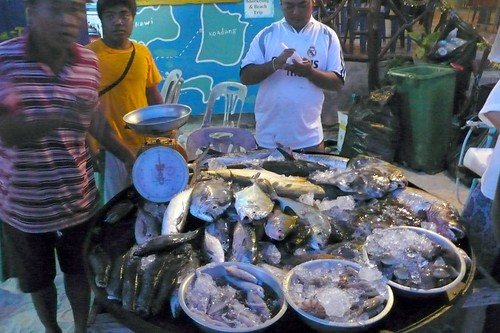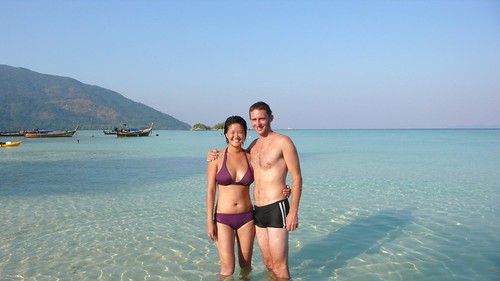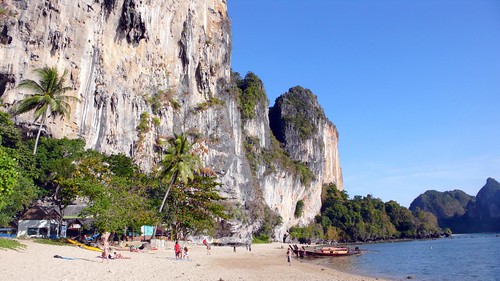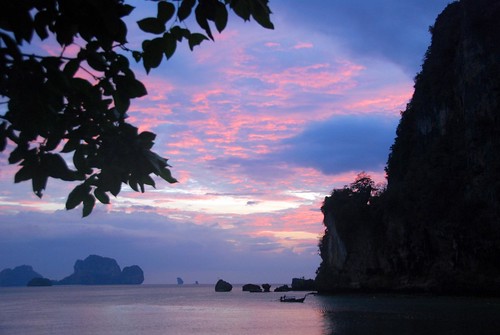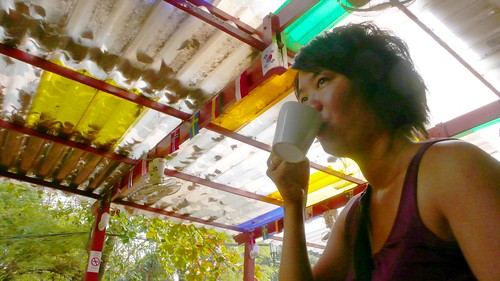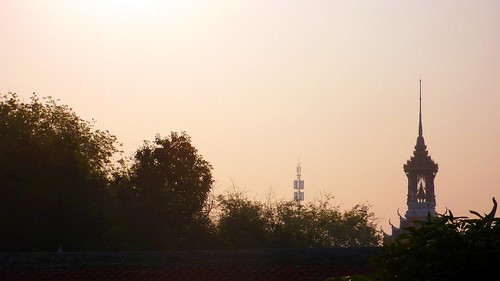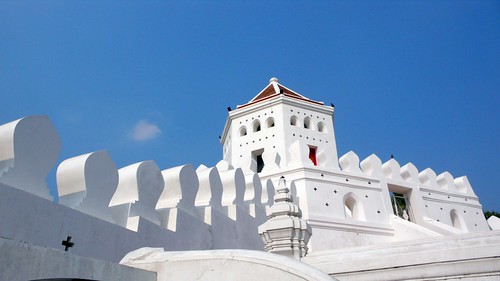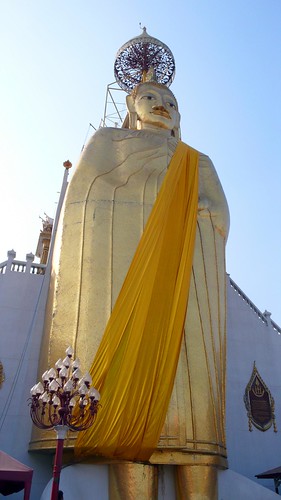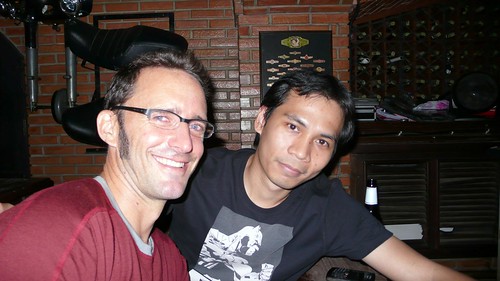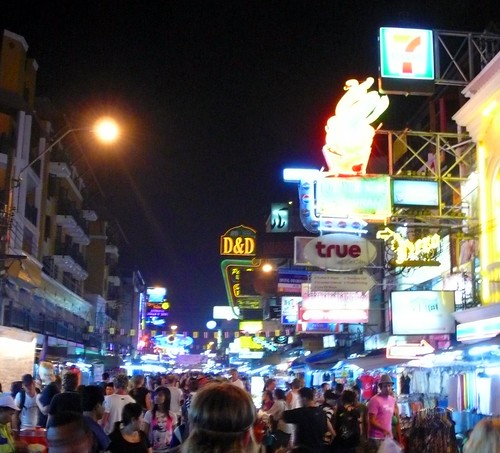Thailand
Ever since I caught the travel bug on my first trip to Central America, I have wanted to visit Thailand. Something about the place held my fascination, though I had but a few expectations before we arrived: that the land would be beautiful (it is), that the people would be peaceful (they are, though the protests right now may suggest otherwise), and that the food would be good (well, you know where we stand on that issue). It’s funny, though…traveling to a new country can be just like shopping from a catalog, you never know if something is going to fit unless you try it on. Despite the beautiful landscape and the gracious people, I have to admit that we left a bit disheartened by some (definitely not all) of our experiences in Thailand. I think it has to do with the fact that there are so many Western tourists in the country…but before you throw up your hands and say, “Oh, Hope and Jeremy didn’t like Thailand because it’s too touristy,” let me explain. It’s not the fact that there are so many Westerners here, I mean, if that’s the case, then shame on us for only adding to the problem, right? Rather, it is tourism’s effect upon the local people that didn’t sit right with us. Perhaps it’s because so many party people and sex tourists come to Thailand, or maybe Thais are just tired of working so hard to embrace the hordes of travelers coming to their country and not getting anything out of it. We found it difficult (in some places) to connect with locals beyond the standard service-industry interactions, leaving us discouraged and a little depressed. To be clear, I don’t blame Thai people at all…they are more than polite and accommodating towards travelers in their country. Rather, I think it is just a social condition that has manifested itself as a result of a few wayward Westerners treating parts of Thailand like their own personal playground.
That being said, I do want to point out that we had a wonderful time with Oak and his wife in Bangkok. I mean, this is a guy who told us (as we were leaving his house for the airport), “You know where your home in Bangkok is.” We know that it’s not every day you encounter that kind of open-heartedness and generosity. So even if Thailand could taste a bit sour at times, we were also left with a sweet taste in our mouths from the experience.
Days spent here: 19
Places we visited: Bangkok, Krabi, Ko Lipe, Chiang Mai
Places we would like to go next time: Similan Islands
Prices: With the exception of Chiang Mai (which is super cheap), we found Thailand to be quite expensive, especially in terms of accommodation. One of the worst rooms we stayed in in SE Asia (in Krabi) was also one of the spendier ones (at US$18.50 per night), and the most expensive room we stayed in all of SE Asia was in Ko Lipe (at US$26 per night). Food in Thailand can be quite cheap, however, as long as you like pad thai and fruit shakes. ![]()
Weather: The weather was beautiful while we were in Thailand. It was hot and dry in the south (at the end of January), and hot and humid in the north (mid-March).
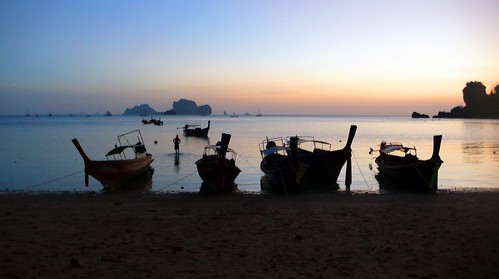
Sunrise over Ton Sai beach in Krabi.
In order to deal with the heat, Thais (apparently) bathe several times a day. They also use baby powder to keep themselves dry, and the options are amazingly broad. There are baby powders with cooling agents, baby powders that help control acne, baby powders that shimmer, baby powders with deodorant…the list goes on. We tried the baby powder thing and we have to say, it is quite refreshing!
Transit: We traveled in Thailand on plane, mini-bus, boat, and train. Mini-buses in Thailand are not the holy terrors that they are in Vietnam…we enjoyed a very comfortable 5-hour ride from Chiang Khong to Chiang Mai via mini-bus transport. Similarly, the train from Chiang Mai to Bangkok was very comfortable, but try to get a bottom bed, as they are much wider than the top berths.
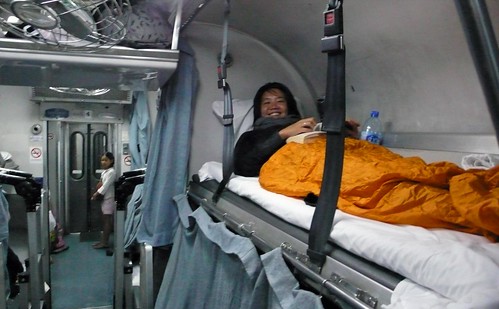
Settling in for the night. On the overnight train from Chiang Mai to Bangkok.
Internet: Wi-fi connections in Thailand are plentiful, though we always had to pay for access (usually between 30 and 50 baht per hour: approx. US$0.85 to US$1.50).
Culture: Thailand is a very Buddhist country, which accounts for the peaceful nature of its people. There are many opportunities to do 10-day introductory meditation retreats at Buddhist monasteries here (which we really wanted to do but alas did not have time for). If you do decide to take part in one of these courses, be prepared to sleep on a concrete bed with a wooden pillow, wake up at 4AM, and deal with rats, snakes, and mosquitos (Buddhist monks do not believe in killing any living creatures, so rodents of all sizes can take safe shelter at their local monastery). Also, you are not allowed to eat after noon (this tenet in particular scared Jeremy).
The other person (besides the Buddha) that Thais worship is their King. Oh my god, do they love their King. You cannot walk a block without seeing his face. Every little hole-in-the-wall restaurant has a small shrine devoted to him with shells and flowers and stickers decoupaged around his portrait. His face is all over their coins and bills, and it Thailand it is against the law to step on money, since to do so is to disrespect the King. By the way, as far as we could gather, the King’s role is sort of like the Queen of England—purely ceremonial.
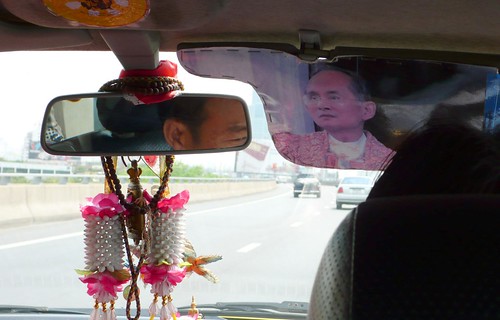
One of our taxi drivers stapled a portrait of the king to his car’s visor. So cute!
The final bit of Thai culture that I wanted to mention is the wai, the standard way of greeting people in Thailand. Basically, you hold your hands together in front of your face and say, “sawatdee” (”hello” in Thai). If someone wai’s you, it is polite to wai back, though the position of your hands does matter. It seems that wai’ing so that your fingertips are touching your forehead is a sign of utmost respect, but when in doubt, just make sure your fingertips are right underneath your nose. Hold your hands too low in relation to your face, and you risk offending someone.
In short: I don’t mean to be too negative about Thailand…in fact, if I think back to the places we visited, we liked all of them and had a really nice time in each location (especially Ko Lipe). It’s just that you can feel the effect of tourism in Thailand more than in other SE Asian countries. I guess it was the surprise of encountering this reality that threw us a bit off balance.
Check out our photos from Thailand:
We’ve come full circle…our final stop in SE Asia was the same place we started: Bangkok. As many backpackers will tell you, you really don’t want to hang out in Bangkok for too long. We did our best to avoid the place but we had some visa issues that needed some attention, so back to Khao San Road we went. It’s funny how much your view of a place changes after you have something to compare it to…when we first flew into Bangkok, Khao San Road seemed fine; nothing to write home about, but we weren’t repulsed by it either. I guess it’s because we had no point of reference. After seeing what the rest of SE Asia has to offer, Khao San seemed like an absolute pit and we couldn’t wait to move on (next time, we think we will stay in the Siam Square area instead).
We didn’t do much else in Bangkok except take care of our visas, but we did manage to see Oak one more time. Oak invited us to stay with him and his wife in their newly-built house as their first overnight guests. It was quite a shock to go from Khao San to their gorgeous, multi-level house. Since the house is so new, it is very sparsely furnished, but you can already see that Oak and his wife Auey’s tastes veer towards the modern: everything is black or sparkling white.
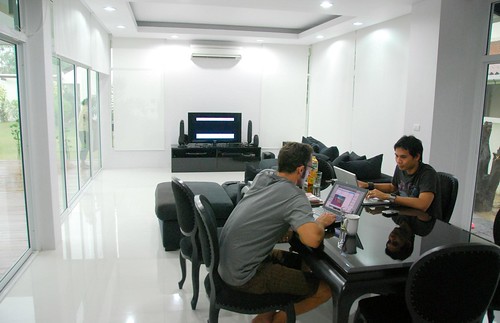
Jeremy and Oak computing at Oak’s dining room table.
It was against this stark white background that we realized: we were dirty. Seriously, we never felt so dirty in our lives…and we fancy ourselves much cleaner than other backpackers! It was embarrassing. We quickly took showers and changed into our nicest (cleanest) clothes. I even put on a pair of earrings, hoping that might distract from our disheveled bodies. I guess we had been amongst dirty backpackers for too long…our hygiene scale got a little skewed. ![]()
We also got to see Oak’s Muay Thai (Thai Kickboxing) manufacturing plant, and he gave us free t-shirts from his line…so nice!

Thai kickboxing gloves at Oak’s warehouse. Buy them here: muaythaistuff.com!
Oak also took us out to a steakhouse…which was amazing! Even better, the restaurant had a Western theme, complete with wagon wheel chandeliers and Thai waiters dressed in Western gear. Thais have this strange fascination with the wild west…we saw many an “Ol’ Saloon” and “Wild West Steakhouse” in Bangkok and Chiang Mai.
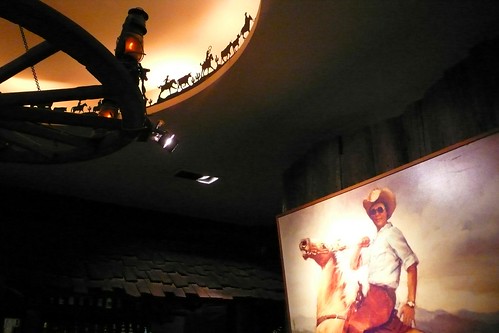
Is it just me or does the Thai cowboy in the portrait look like my dad?
It was a great way to close out our trip: great food (notice that we did not want Thai food for our last meal in SE Asia) ;), followed by a night out with new friends, ending in the comfort and luxury of sleeping in Oak & Auey’s (gorgeous) house. We had a great time in SE Asia, but we’re looking forward to the next chapter in our trip: Taiwan!
Chiang Mai is the only major stop on the backpacker circuit in northern Thailand, and it seems to have a little something for everyone. For the spiritually-minded, Chiang Mai has a plenitude of wats, some offering 3-10 day meditation retreats (which we seriously considered but didn’t have time for) or afternoon “monk chats.” For the active traveler, Chiang Mai is a very popular place to book a multi-day trek to visit hill-tribe villages, including the famous “long necks” (i.e., women from the Kayan-Padaung tribe who wear brass rings around their throats, giving their necks an elongated look). And for the shopper, Chiang Mai is famous for it’s handicrafts and night markets, selling everything from embroidered textiles to paper umbrellas. With so much to see and do, you can’t go wrong, right? Well, read on, my friends…Chiang Mai was really lovely but one thing in particular really ended up being the thorn on our rose.
As a city, Chiang Mai is pretty cool. The city center used to be walled in and protected by a moat, though little of the wall remains except for the corners and the city gates. Still, it’s pretty neat! I mean, how excited would you be to live in a town with a freakin’ moat?!?
Within the walls sits a plethora of wats…you can’t walk a block without running into one, they are like Starbucks here. We spent many a day wandering around wats. The “Big Three” within the walled city are Wat Prasingh, Wat Chiang Mun (the oldest wat in Chiang Mai) and Wat Jedi Luang.
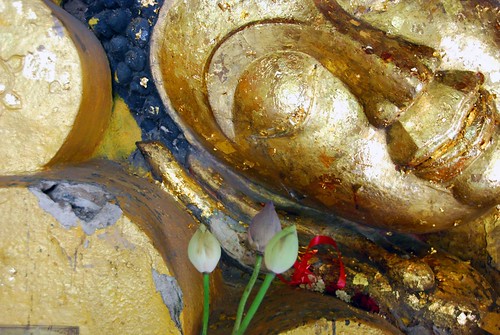
Big sleeping Buddha at Wat Jedi Luang.
In the back of Wat Jedi Luang, there are some beautiful old teakwood buildings that contain life-size wax replicas of monks within plexiglass display cases. Needless to say, we were surprised, fascinated, and a bit creeped out by these.
One day, we rented bikes and rode out to Wat Umong, a forest wat outside of the city center, in order to attend a talk by a western monk entitled “What Buddha Taught.” It was really informal…there were only about 6 of us sitting around an outdoor gazebo listening to a monk talk about the Buddha’s teachings. Jeremy and I have been practicing meditation lately and we’ve become really interested in learning more about Buddhism. The talk was super interesting and the monk (we think he was English) was surprisingly well-versed on current events; during his talk, he mentioned the credit crisis, iPod touches, and the contemporary Australian philosopher Peter Singer. I didn’t take any photos at the talk, but Wat Umong itself was really lovely. It is not ornate and gilded like the wats in the city center, and the rustic nature of the grounds is thoroughly charming.
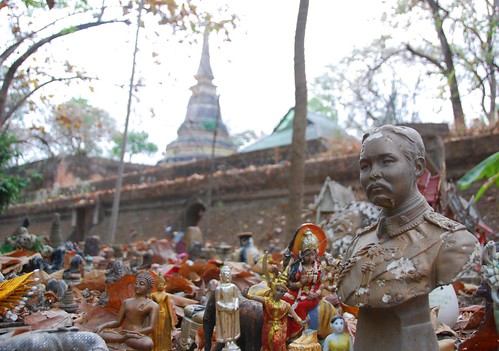
Random assortment of icon relics at Wat Umong.
Also, this wat is unusual in that it has an assortment of tunnels that lead to little altars and shrines to the Buddha.
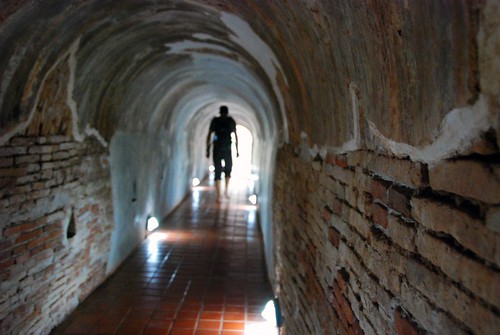
The underground tunnels at Wat Umong.
There are a few sights right outside of Chiang Mai that are really popular, too. You’ll have to rent a scooter (as we did) or take a tuk-tuk to get to Bo Sang, a “handicraft village” (if by “village” you mean, “street with shops”). It was kind of lame, but we did wander around some of the alleys off the main drag and there are families actually producing things like handmade paper and painted umbrellas (apparently Chiang Mai is really well known for these).

Handmade paper drying in the sun.
We also scooted out to Mount Suthep, where Wat Phrathat Doi Suthep (a.k.a. “The Wat on the Mountain”) is located. It was a really lovely place, but incredibly crowded, too.
There weren’t any wax-figure monks in plexiglass cases at this wat, but they did have this weird thing:
Apparently whoever made this statue did not think too highly of their mother. Or there is a cultural “lost-in-translation” moment here that we are not understanding.
So enough about wats…what about the other activities that Chiang Mai has to offer? Well, we didn’t end up going on a trek because, like northern Laos, it is burning season in Chiang Mai too, and after our Luang Nam Tha experience, we decided to skip it. I think this was a good decision, because the day we rented the scooter, both Jeremy and I had problems with the smoke…I ended up with a sore throat and cough for days, and the white spots on my purse had turned completely grey. Gross!
We did, however check out Chiang Mai’s biggest tourist attraction: the markets. We were lucky enough to be in Chiang Mai on a Saturday and Sunday, so we got a taste of the weekend mayhem. Saturday night’s market is much smaller and more relaxed…Sunday’s market is absolutely nuts! The entire length of the main street in Chiang Mai’s city center is blocked off and the road is filled with handicraft stalls, people offering cheap massages, and snack treats. Even if you had the energy to walk from one end to the other, it would take you hours, since the wall of people is so thick. It was so crowded, Jeremy couldn’t deal with it and went home early. ![]()
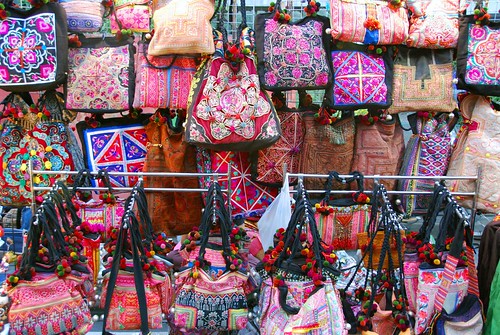
Amazing embroidered purses at the Sunday market.
So…wats, treks, and markets, what more could you ask for, right? Well, the thing is…are you ready? You might want to sit down.
Jeremy and I don’t like Thai food.
I know! Can you believe it? Us! Lovers of all cuisine! Equal opportunity eaters! We just don’t care for one of the world’s favorite ethnic foods! I was shocked to find out too! But guess what? It was a two-way street: Thai food doesn’t like us either. We had (ahem) issues in Chiang Mai…to the point where we were afraid to even eat Thai cuisine. We actually sought out Western food like spaghetti and hamburgers in Chiang Mai. I know! Us! Can you believe it? I mean, we ate congealed pig’s blood cakes (unknowingly, but still) in Penang, and something called “cockles.” And it was northern Thai food that took us down.
It was depressing. When you love food as much as we do, you can have the most amazing time in a place, but if the food’s not good (much less, making you sick), then it’s hard to really enjoy yourself. And the weird thing is, we like Thai food in the States. We just didn’t like it in Thailand.
So, there you go…that was our Chiang Mai experience: days spent lazily wandering in and out of beautiful wats, an incredibly interesting talk by a local monk, riding around the walled city on our rented bicycles…but the pea under the princess’ mattress was the food.
Sorry, Chiang Mai. Let’s just agree to disagree, shall we?
As I mentioned in the previous post, we really didn’t have a plan in place for SE Asia…which in many ways is really good for us (or at least, me)—to learn how to be comfortable with the uncertainty of not knowing where we are going to sleep or even what city we are going to be in the next day. BUT, this also means we spend a ridiculous amount of time trying to figure out what the heck we’re going to do next. We had originally planned to go diving in Ko Phi Phi, but we found out from some people on Ton Sai that (1) Ko Phi Phi is a big, noisy scene full of kids getting drunk and foreign men and their “Thai wives,” and (2) that the diving is better in Sipadan (in Malaysian Borneo)—actually, rumor is that it is the best diving in the world. So, we decided to check out another island in Southern Thailand (island hopping is a big thing here), and save our diving dollars for Sipadan.
Oh, but what island to go to?!? I know, I’m not expecting anyone to throw us a pity party for this quandary…but we really spent a lot of time changing our plans back and forth. For a while, we were heading to Loh Liang, a tiny island with one resort where a lot of climbers go from Krabi. Then we thought maybe we should dive in the Similan Islands. Finally, we decided (after hearing rave reviews from several people we met on Ton Sai) to head to Ko Lipe, a small island at the very southwestern tip of Thailand in Ko Tarutao National Park. And we were sooo glad we came.
We took a long tail boat from Ton Sai to Ao Nang, a bus from Ao Nang to Pakbara, and a speed boat from Pakbara to Ko Lipe. There are three main beaches in Ko Lipe: Sunrise beach, Sunset beach, and Pattaya, with the last beach being the busiest. One of the gals in Ton Sai said we should stay at Coco Resort on Sunrise beach, and it didn’t take us long to realize that we basically had the best spot on the island.
The strip of Sunrise beach right in front of Coco Resort was quiet, pristine (look at that water!!!), and peaceful; even a few meters down the beach was more crowded and noisy. Plus, Coco Resort was a lovely little place run by a Thai family…we negotiated a bamboo bungalow for 900 baht per night (approx. US$26) the first night, and it seems like this might be one of the cheaper places on the island to stay. The bamboo room was very atmospheric but the floor felt like you could fall right through it. Later we would see that half the posts supposedly supporting the bungalow were several inches too short and didn’t reach the ground (scary!!!).
So the following day we moved to a concrete bungalow (700 baht/US$20 per night), which felt a little more solid. ![]()
We spent three days here swimming, reading on the beach, and generally enjoying the beauty that is Ko Lipe. And, on one particularly inspired day, we watched the sunrise on Sunrise Beach:
And the sunset on Sunset Beach:
We had some great dinners here too…there is a place at the very end of Pattaya beach where you can walk up and choose your fish from a huge platter of iced seafood treats. They weigh it, grill it, and serve it to you at your table on the beach. YUM!
We LOVED Ko Lipe!
We really didn’t have a plan as to where we were going after we arrived in Bangkok…and, as we’ve discovered, even if you *think* you have a plan, SE Asia has other ideas for you. ![]() Jeremy remembered that a friend of ours from SF, Jeremy Sugerman (I will refer to him as “Sug” to avoid confusion), is often in Thailand for 6 weeks around January/February, so we emailed him…and sure enough, he was in Krabi, a small beach town in Southern Thailand near Phuket which is known as “Climber’s Paradise” due to the fact that it is surrounded on all sides by enormous limestone cliffs. We’ve heard about Krabi for years because many San Francisco climbers often visit. That, combined with the fact that Sug was there, was all the reason we needed to head down south.
Jeremy remembered that a friend of ours from SF, Jeremy Sugerman (I will refer to him as “Sug” to avoid confusion), is often in Thailand for 6 weeks around January/February, so we emailed him…and sure enough, he was in Krabi, a small beach town in Southern Thailand near Phuket which is known as “Climber’s Paradise” due to the fact that it is surrounded on all sides by enormous limestone cliffs. We’ve heard about Krabi for years because many San Francisco climbers often visit. That, combined with the fact that Sug was there, was all the reason we needed to head down south.
We booked a flight to Krabi in Bangkok. In SE Asia, you can book airline tickets the day before you want to leave, and they’re still pretty cheap. Also, the price a travel agent can offer can be cheaper than one you can find on the internet. We spent about 2500 baht (approx. US$75) per person for a one-way flight from Bangkok to Krabi. This isn’t a rock-bottom price, but given the fact that the bus ride to Krabi is 10 hours long, we decided to spend the dough.
Sug was staying on Hat Ton Sai in Krabi, a tiny beach area accessible only by boat. So, after we got off the plane in Krabi, we took a bus to Ao Nang, where we boarded a longtail boat to Ton Sai. That’s a lot of different transportation for one afternoon! It was low tide where we got to Ao Nang, which meant we had to walk through the water to board the boat since they can’t get to shore (and there is no pier). Thank goodness we have hybrid wheelie/backpack bags! We had agonized over this decision before we left on our trip—Jeremy just wanted a wheelie duffel bag and I insisted that he find a bag with backpack straps. In true Hermann fashion, Jeremy found the bag that worked for him, and then rigged up a backpack using detachable straps. Hey, whatever works. ![]() I felt really bad for the people who didn’t have backpacks. None of us expected that we would have to haul our bags across the beach and then through the water, but it was extra tough for the non-backpackers and some of their bags got quite wet.
I felt really bad for the people who didn’t have backpacks. None of us expected that we would have to haul our bags across the beach and then through the water, but it was extra tough for the non-backpackers and some of their bags got quite wet.
The boat ride into Krabi is really beautiful. Krabi is a stunning place—it is quite dramatic with all the rocky cliffs—and the landscape is very different from other parts of Thailand.
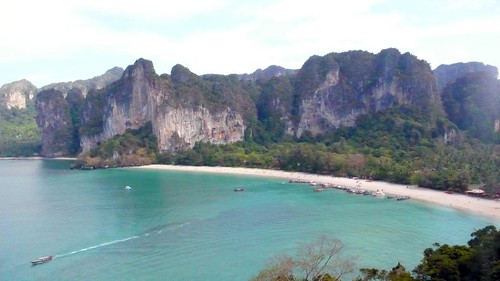
View of Rai Leh beach from Thai Wand, Ton Sai is the next beach over (to the left).
Sug had hooked up a room for us at Dream Valley Resort, where he was staying. Our bungalow was cute from the outside, but quite basic inside, and at 650 baht (approx. US$18.50) per night (including breakfast), it was one of the cheapest places to sleep. This means Ton Sai is not the most economical accommodation in Thailand, but it is certainly a lot cheaper than the next beach down, Hat Rai Leh, where rooms can go for at least 2000 baht per night. Ton Sai is run on generators, so you only have electricity in your room from approx. 6:30PM until 8AM. At least you can run the fan at night! A few more details: the toilets do not flush (you have to dump a bucket of water down the loo), the showers are cold, and the beds are HARD! Even for Jeremy and I (we love a firm bed), these beds were like concrete slabs. So, very basic indeed!
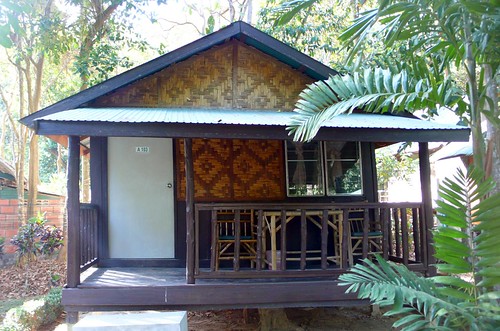
Our bungalow at Dream Valley Resort.
But most people are not in Ton Sai for the accommodation: they are there to climb. Literally, every rock wall you see has been bolted and there are people climbing it. It really is a sport climber’s paradise. Given that Jeremy and I have not been on a wall for over a year (and probably at least 5 years since we’ve been on real rock), we didn’t pack any gear with us on our trip. But it’s easy enough to rent shoes and a harness here on Ton Sai.
Our first day out, we went with Sug, Janet (a great gal—Sug’s friend visiting from SF), and Sug’s friends Chris and Kindy (who have a gorgeous house in Rai Leh) to Thai Wand wall, and then to another location (I forget the name). NOTE: We took to calling Sug the “Mayor of Ton Sai,” because he knows EVERYONE! He has come to Krabi for the last 9 years (and he stays 4-6 weeks each time), so he truly is the mayor.
And, the awful truth: I was pumped out after two climbs. Jeremy managed to finish 4 climbs that day.
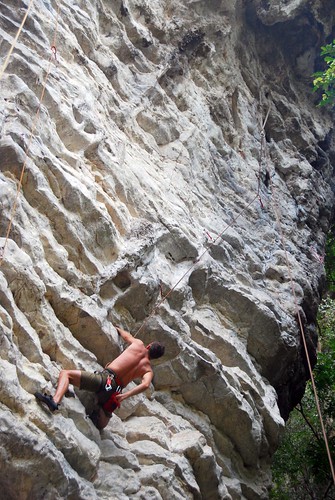
Jeremy on…some difficult route.
We ended the climbing day with beers at Sawasdee bar at sunset.
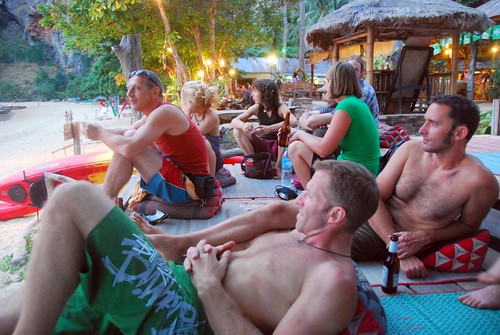
The Jeremies watcing the sunset from Sawasdee.
In fact, this is part of the general “schedule” of events every day on Ton Sai: get up early, eat breakfast, climb, lunch at the chicken ladies (some women who have food stalls by the beach selling yummy grilled chicken), climb more, beers at Sawasdee bar at sunset, followed by dinner at Banyan Tree.
Jeremy and I couldn’t take part in this daily routine the following day because we were SORE. Oh my, a year off the rock and we were little weaklings. So, we decided to go out sea kayaking. Hey, guess what? It turns out that the same muscles you use to climb are the ones you use kayaking. So, it wasn’t much of a rest day for us. ![]()
Jeremy and I planned on staying in Ton Sai only about 3 days or so, but then, as I said earlier, SE Asia had other plans for us. Jeremy came down with a case of “Ton Sai belly,” a stomach virus that kept him bedridden for about 24 hours. So far, I had escaped the virus (Sug had it the day before), so I went out climbing at Eagle wall with Janet and a cool German girl named Hannah.
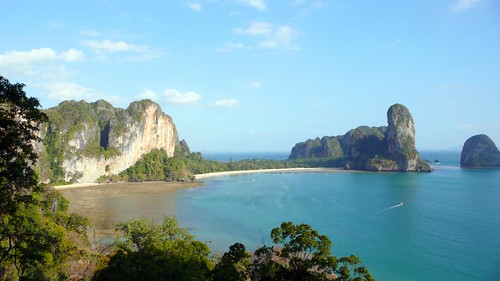
Taken from the summit at Eagle wall.
Again, my limit was two routes, but this time it wasn’t my muscles but my belly: I felt the rumblings and the cramps…I had came down with the virus too. ![]() Let me tell you, it’s no fun being stuck in a bungalow with no air conditioning (much less electricity) when you’re sick. And, the bed felt even harder than hard with all our achy muscles against it.
Let me tell you, it’s no fun being stuck in a bungalow with no air conditioning (much less electricity) when you’re sick. And, the bed felt even harder than hard with all our achy muscles against it.
But honestly, it wasn’t so bad for our first time being sick. It only lasted a day and the cramps definitely weren’t as bad as the times I had food poisoning. Besides, we need to toughen up our stomachs if we are going to make it through Asia.
So, we ended up staying in Ton Sai a little longer than we wanted to, and I have to be honest here: even though the climbing is great, I still can’t understand why all the climbers think it is heaven on earth in Ton Sai. Many people literally stay for months and they can’t even fathom why you would want to leave. I mean, it’s nice, but the beach is a bit polluted and during low tide the shore is muddy and littered with dead coral. Plus, Jeremy thinks water table is contaminated (the water coming out of the sink is quite stinky), which basically means there is no way you can stay healthy on Ton Sai, because everything is washed in this water. Honestly, it kind of grossed us out a bit. Maybe I am being too prissy, but I just thought, “Thailand HAS to get better than this.”
But I don’t want to end on to sour a note. We had a great time climbing again and it was fun hanging out with Sug and meeting Janet. We met a lot of cool people who helped us figure out where to go in SE Asia and how to get there. But in the end we were glad we were only spending a few days in Ton Sai. ![]()
There is only one flight from Hong Kong into Bangkok via AirAsia each day, and that flight arrives in Bangkok at 11PM. We knew that by the time it we took the taxi/train/bus into the city, it would be quite late. And here’s the kicker: you can’t really make a reservation in SE Asia. Well, you can, but not if you are a budget traveler. We read in the Lonely Planet that most budget hostels/hotels/guesthouses don’t take reservations, and even if they do, sometimes you show up and your reservation (along with your down payment) has mysteriously disappeared. So, your best bet is to just show up and start looking for a room in one of the guest houses. It made me a little nervous that we didn’t have a place lined up to stay for the night, but that’s how it is here in SE Asia, and the uncertainty is part of the adventure here.
BTW, if you are ever considering traveling around SE Asia, we HIGHLY recommend that you pick up a Lonely Planet. Jeremy and I aren’t really the guidebook types, preferring to just figure stuff out along the way, but the little yellow book is indispensable here. Seriously, there is just so much you have to figure out about each country (buses, places to stay, local customs, food, etc.)—much less each town in each country—and there is no way you can figure all that out on your own, no matter how many people you talk to. Of course, we don’t take it as gospel—we’ve already found some of their comments to be incorrect in our experience, but the LP does help point you in the right direction. For example, the LP “recommended” hostels are probably pretty nice, but we haven’t stayed in one yet, because they are usually completely booked with other travelers (who also have their own copies of LP). Typically, we just look in the guide to get an idea of where the budget hostels are concentrated, and we head to that area, stopping by each guesthouse to enquire about rates and vacancy.
So that’s exactly what we did when we arrived in Bangkok…at midnight. We headed to Soi Rambuttri, a smaller alleyway off Khao San Road. We started at one end of Soi Rambuttri and stopped at each guesthouse (and there is pretty much one guesthouse every few feet on this road), asking if they had any beds available for the night. We must have asked at least 15 places for a room until we found a vacancy at Baan Sabai, and we snapped the room up right there on the spot. So it kind of looked like a prison cell and the shared bathroom didn’t come with toilet paper (actually, we would come to find out—none of the budget rooms in Thailand come with toilet paper), but it was a place to lay our heads for 290 baht (approx. US$8.25), and that was good enough for us.
Many of the guesthouses in Thailand have little restaurants attached, and in the morning, we headed down for a much-needed cup of joe and people-watched from our guesthouse cafe.
A couple things we noticed:
1. In Thailand, the street sweepers are people rather than large machines. A huge swarm of people with bamboo brooms came by sweeping the floor, followed by a large water truck flooding the ground, followed by more sweepers. The street was spic and span afterwards, too.
2. There were a shocking number of people drinking huge beer Changs for breakfast. I should mention that these people were travelers, not Thais.
After breakfast, we moved to a new guesthouse (though to be fair, we saw some of the other rooms at Baan Sabai on our way out and they looked pretty nice). We moved down the street to Bella Bella House, and our room, while nondescript, did have its own bathroom with a hot shower (though we still had to buy our own toilet paper) for 420 baht (approx. $12). And, it did have a nice view of the neighboring temple:
We weren’t in Bangkok very long. Like most people, we stayed only a few nights one our way to the islands. But, we did walk around and see a few temples:
As well as a 40 foot standing Buddha:
And we got to meet Oak, a super nice Thai guy we met through Robert, who met him through our friend Gabe. BTW, Oak runs a website that sells Thai kickboxing gear: http://www.muaythaistuff.com. Get all your, um, Thai kickboxing gear from him!
Oak took us out on the town, and we finally saw Khao San Road, which was total mayhem! There were hundreds of tourists on that tiny street, along with food vendors, contortionists, singing transvestites, people selling clothes…you name it, you can find it on Khao San. We couldn’t believe this carnival so close to our quiet little alley, and we thanked our lucky stars we weren’t staying on this street (I’m not sure how you would sleep with all the lights and noise).
We’ll come back to Bangkok, perhaps in a few weeks on our way to Burma, perhaps in two months on our way out to Taiwan. Oak has kindly offered for us to stay with him when we come back through, and once again, we are surprised and touched by amount of generosity we’ve been shown so far on this trip. If Thailand can foster this kind of hospitality towards it’s visitors, it’s gotta be a great country…even if you do have to BYOTP. ![]()
